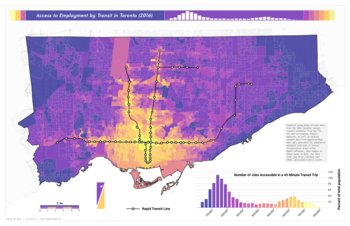
In transport planning, accessibility refers to a measure of the ease of reaching (and interacting with) destinations[1] or activities distributed in space,[2][3] e.g. around a city or country.[4][5] Accessibility is generally associated with a place (or places) of origin. A place with "high accessibility" is one from which many destinations can be reached or destinations can be reached with relative ease. "Low accessibility" implies that relatively few destinations can be reached for a given amount of time/effort/cost or that reaching destinations is more difficult or costly from that place.
The concept can also be defined in the other direction, and we can speak of a place having accessibility from some set of surrounding places. For example, one could measure the accessibility of a store to customers as well as the accessibility of a potential customer to some set of stores.
In time geography, accessibility has also been defined as "person based" rather than "place based", where one would consider a person's access to some type of amenity through the course of their day as they move through space.[6] For example, a person might live in a food desert but have easy access to a grocery store from their place of work.
Accessibility is often calculated separately for different modes of transport.[7]
- ^ Cite error: The named reference
Farber 2017was invoked but never defined (see the help page). - ^ El-Geneidy, Ahmed; Levinson, David (2006-05-01). Access to Destinations: Development of Accessibility Measures (Report). University of Minnesota Twin Cities. hdl:11299/638.
- ^ Song, Ying; Miller, Harvey; Stempihar, Jeff; Zhou, Xuesong (2017-10-01). "Green accessibility: Estimating the environmental costs of network-time prisms for sustainable transportation planning". Journal of Transport Geography. 64: 109–119. doi:10.1016/j.jtrangeo.2017.08.008. ISSN 0966-6923.
- ^ Andrew, Owen; Brendan, Murphy (2018). Access Across America: Transit 2017 (Report). University of Minnesota Twin Cities. hdl:11299/199920.
- ^ Owen, Andrew; Levinson, David M. (2016-10-08), "Developing a Comprehensive U.S. Transit Accessibility Database", Springer Geography, Springer International Publishing, pp. 279–290, doi:10.1007/978-3-319-40902-3_16, hdl:11299/180074, ISBN 9783319409009
- ^ Miller, Harvey J. (2005-12-06), "Place-Based Versus People-Based Accessibility", Access to Destinations, Emerald Group Publishing Limited, pp. 63–89, doi:10.1108/9780080460550-004, ISBN 9780080446783
- ^ Iacono, Michael; Krizek, Kevin; El-Gemeidy, Ahmed (2010-01-01). "Measuring non-motorized accessibility: issues, alternatives, and execution". Journal of Transport Geography. 18 (1): 133–140. CiteSeerX 10.1.1.558.6960. doi:10.1016/j.jtrangeo.2009.02.002. ISSN 0966-6923.
